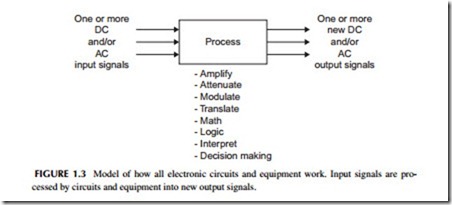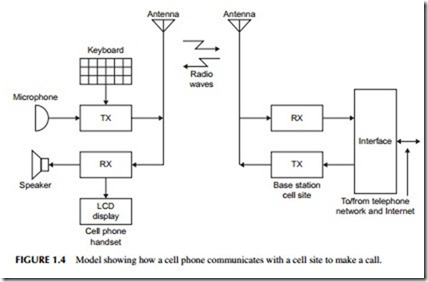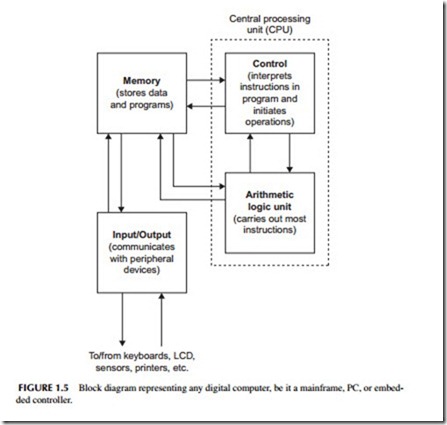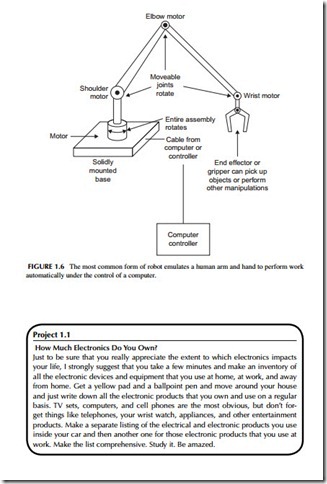THE PAINFUL TRUTH
Okay, here comes the hard part. Electricity is moving electrons. An electron is a tiny particle that is inside the atoms that make up everything we can feel, see, and even not see. If we can get some electrons moving together in a wire, electrical or electronic component, or circuit, we can control them to do many useful things, such as amplification, for example. Moving electrons make up what we call current flow. And current flow is produced by electrical energy called voltage. Voltage comes from batteries, the AC wall outlet, and lots of other sources including power supplies, solar cells, microphones, and the like. If we can control the electrons we can produce magic results. That is what electronics is all about.
We control the electrons with components like resistors, capacitors, induc- tors, transistors, and all sorts of integrated circuits. We create circuits that actually process the electron flow. We can call the voltages that create current flow and the resulting current signals. The circuit processes the signals to produce the end effect that we want, be it a radio, a computer, or DVD player.
One of the basic models I will use in this book is shown in Figure 1.3. Think of electronic signals as the inputs to a circuit or piece of equipment that processes the signals producing new signals that represent the output we want. Think of the small voltage that comes from a microphone when you talk into it. It is basically too small to be useful. So we apply it to a circuit called an amplifier that makes the signal bigger and more useful. That amplifier processes the signal to make it large enough to drive a speaker as our desired
output. The result is a public address system. Anyway, you get the picture. Just remember that all electronic circuits and equipment are based on this model: INPUT-PROCESS-OUTPUT. Think about it.
Here are a couple of other examples to show how most electronic things work.
Cell Phone
Take a look at Figure 1.4. On the left is a cell phone handset. It is made up of two major pieces–a transmitter (TX) and a receiver (RX). You talk into a microphone and generate a small electrical voltage or signal representing your voice. The transmitter takes that and processes it in such a way that the voice controls or modulates a high-frequency radio signal. That signal carrying your voice is then radiated by the antenna to a cell site or base station. The base station receiver picks it up and processes it back into the original voice signal where it then undergoes other processing before being sent over the telephone network to its destination. The dialing process or text messaging from the key- board also generates input signals that are transmitted to the base station.
On the return side, the voice from your caller passes through the cell phone network to the base station and it is then used to control the transmitter to send that voice to you by radio. The transmitter sends the signal to the antenna that sends the signal to the receiver in your cell phone. The receiver processes the signal by amplifying, demodulating, and otherwise processing the voice that eventually is sent to the speaker that is glued to your ear. Another output may be a text message on the liquid crystal display (LCD).
Computers
The main function of a computer is to store and retrieve data, process data, and to provide automatic control. Data consists of information, facts, and figures. It may be numbers, letters, symbols, or text of any kind. It might represent
names and addresses, parts inventory, accounting or banking figures, control signals, or a variety of other items. Data may also be graphics and illustrations, or voice and video that are converted to data. Such data can be stored electron- ically in computers and rapidly accessed.
Computers process or manipulate data in many different ways. They can perform mathematical operations on it, sort it, edit it, translate it, or otherwise operate upon it to produce some useful output. Computers also make decisions based on the data.
Computers have so many applications that it is difficult to enumerate them. In general, computers are tools that help people organize and perform their work in a more efficient manner. Computers also allow people to do work that was difficult or impossible to do without computers. Computers perform accounting and banking operations; store and process mailing lists and employee records; solve complex mathematical problems in business, science, and engineering; and create graphics. The thing that makes them so valuable is that all of their operations are automatic. Humans need not be a part of the actual computation, as is necessary with a calculator. Computers carry out preprogrammed assignments to solve various problems or perform operations. Most operations are extremely fast. It is this automatic feature that makes computers so useful.
All computers, regardless of their size and features, are made up of the four basic sections shown in Figure 1.5. The memory electronically stores the data to be processed, as well as the program that tells how the data is to be manipulated. The program is a sequence of codes or instructions that cause the computer to carry out its preprogrammed assignment one step at a time.
Refer again to Figure 1.5. The control section examines the program instructions one at a time in sequence, interprets them, and then sends control signals to all other parts of the computer. The desired operations, such as store, add, print, and so on, are carried out.
The arithmetic logic unit (ALU) is the section that actually carries out most of the processing. It performs data transfers, arithmetic operations, and logical decision making. In most computers, the control and ALU sections are integral units that work closely together. They are usually referred to as the central processing unit (CPU). A microprocessor in a personal computer is a single chip or central processing unit.
The input/output (I/O) section in Figure 1.5 is the interface between the computer and the outside world. It communicates with peripheral devices that humans use to input programs and data, and receive the output results of computation. Data and instructions are usually entered via a keyboard, while outputs are displayed on a video screen or printed out. Inputs may come from sensors and output may go to a printer or LCD readout.
There are many sizes and types of computers. Supercomputers are the largest and fastest computers. They are used primarily for difficult, complex scientific and math problems. Mainframe computers are also very large, and they are used by business and government for financial applications, data storage, and other applications. Personal computers are the smallest practical computers in use. Millions of them are used for word processing, financial spreadsheets, database management, and email and Internet access.
There are also many dedicated computers, built into other equipment to perform single-purpose operations unlike the general-purpose data processors described above. Thanks to semiconductor technology, it is now possible to put an entire computer on a single chip you can hold in your hand. These are called embedded computers, or microcontrollers. These microcomputers are used like components and are built into most other kinds of equipment such as TV sets, microwave ovens, gasoline pumps, washing machines, and many others. Virtually every other electronic product contains at least one or more embedded controllers. And even very large ICs have controllers on the same chip called cores.
Robots
A great example of a control device is a robot. Most robots consist of an electromechanical manipulator arm used in manufacturing operations. Robots are machines designed to mimic human capabilities. Most robots simulate a human arm and hand. As a result, a robot may be able to substitute for a human in certain manufacturing jobs. A typical robot manipulator arm is shown in Figure 1.6. Motors operate shoulder, elbow, and wrist joints, while grippers and other tools form the hand that does the work.
Robots help automate the manufacturing process to increase productivity. They lower costs, produce more goods in less time, and improve quality. Robots also replace humans in many jobs requiring repetitive, tedious, and hazardous work.
Robots perform a variety of tasks in industry. The most common are welding, spraying or painting, and “pick-and-place” operations. Various tools on the end of the manipulator arm, called end effectors, let the robot per- form a remarkable variety of tasks. In addition, a programmable controller or computer is used to control the robot. A robot may thus be programmed to perform a wide variety of jobs and is easily reconfigured when the work changes.
In subsequent chapters you will see more of these kinds of descriptions. But in Chapters 2, 3, and 4, you will learn a few more basics that make the rest of the book more understandable.




